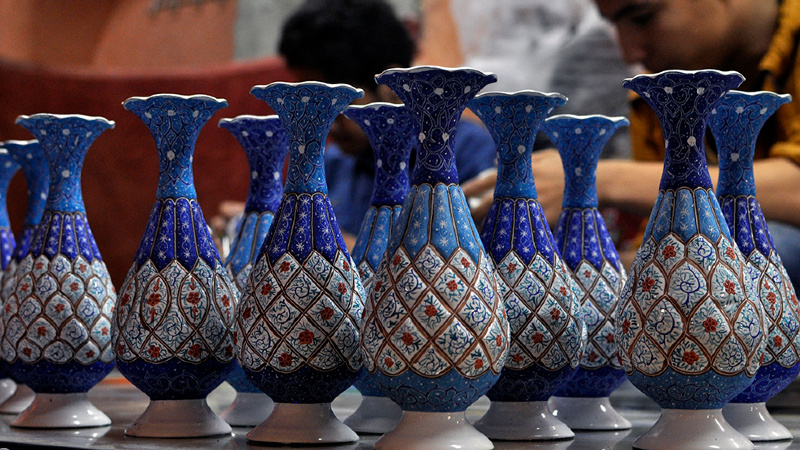Minakari or Mina is one of the oldest Persian handicrafts, which is nearly 5000 years old. This art includes painting on different metals such as gold, silver, copper and also painting on pottery. Minakari is a kind of handicraft related to decorating various dishes and objects and creates one of the most beautiful handicrafts.
History of Mina Kari
According to historical documents, the art of Mina Kari was created in Iran, and then many sculptures and decorations were made in other countries of the world, including Greece, inspired by Iranian works. Part of the statue of Zeus at Olympia in Greece is decorated using this art. This statue, which is one of the seven wonders, is about 2500 years old and is one of the most valuable works in the art of sculpture.
The oldest type of enamelware in Iran is related to the Achaemenid Empire. This object is a pair of gold earrings which, according to archaeologists, dates back to 700-800 BC. These earrings are made of gold and an enameled glass glaze is drawn on it.
In addition to these earrings, a gold bracelet and a bronze metal bowl, which is related to the Achaemenid Empire, have been found in archaeological excavations, and various decorations have been made on it using this art.
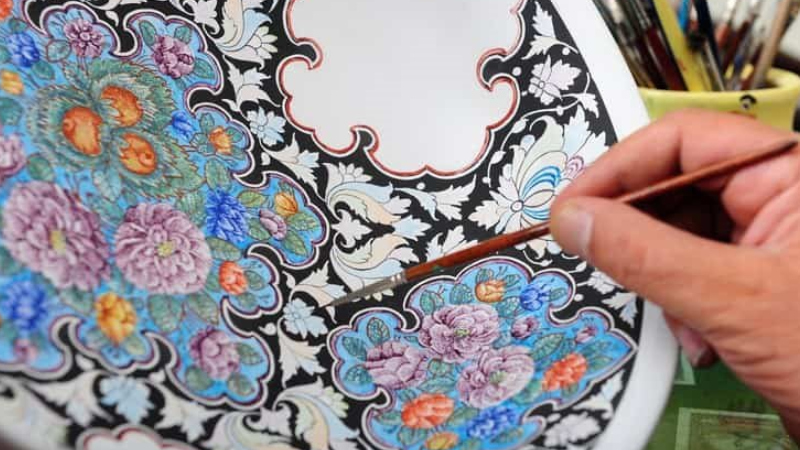
Using Mina Kari to decorate things
Enamel was also used in the Sasanian Empire. During this period, this art was used to decorate various dishes. Examples of plates decorated with enamel art from the Sasanian Empire are kept in famous museums in the world, including the Metropolitan Museum in New York.
In the Seljuk dynasty, this art was used to decorate various vessels made of brass or silver, and the decorated objects were also exported to different countries. During this period, the first commercial use of enamel art was made.
With the popularization of this art in the Seljuk dynasty, Mina Kari flourished so much that in the following periods, including the Timurid Empire and the Ilkhanate, this art was not only related to the decoration of dishes but was also used in the design of rich people’s clothing.
Mina Kari changes and more complicated designs
In the Safavid dynasty, the appearance of enamel changed from simple designs to more complex motifs such as miniatures. In addition, the colors used in enamel designs became more diverse and red became one of the main colors used in this art. In this period, enamel paintings of flowers, different plants, designs of knights’ battles, animals and birds were drawn. The color of these paintings consisted mostly of green, red, yellow and pale blue colors.
The city of Isfahan was the capital of Iran during the Safavid era, and for this reason, most of the enamel artists lived in this city. In addition to Isfahan, this art was also practiced in the cities of Kashan, Ray and Tos. One of the reasons why the city of Isfahan is known as the main center of enamel work in Iran today is related to the prosperity of this art in this city during the Safavid dynasty.
In the Qajar period and after, Mina Kari was used to decorate many different dishes and objects, including hookahs, earrings, water bottles (Persian: گلاب پاش), and even parts of clothes such as belts.
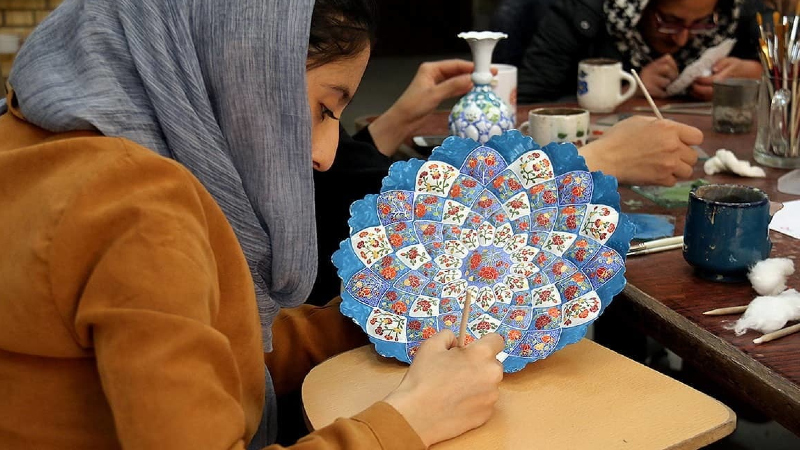
Types of Mina Kari
In terms of production method, enameling is divided into two categories: painted enameling and meshed Mina Kari. Each of these two items has a specific production process and is produced only for a certain purpose.
enamel painting
This type is the most common type of enamel art. In this type, first the vessel or the desired object is made of copper or pottery, and then a layer of ceramic is drawn on this vessel.
This work is called Ceramic glaze (Persian: لعاب کاری) and it must be done 3-4 times, and each time, the desired dish is placed in a furnace at 900 degrees Celsius to fix the Ceramic glaze on the dish. After that, the target container is completely whitened and enamel painting is done on it.
After finishing the painting, the container will enter the furnace again and it will be heated at the same temperature.
meshed enamel
This type of Mina Kari is an old method. In this method, thin copper wires are connected to each other with a desired design and after gluing them on the desired container or object, they are placed inside the furnace. High heat causes the wires to weld to each other and different holes are formed on the container.
After that, the enamel colors are poured into the holes and the container is returned to the furnace to fix the color. This type of enameling is one of the most laborious Iranian handicrafts and currently it is produced only in the two cities of Isfahan and Tehran.
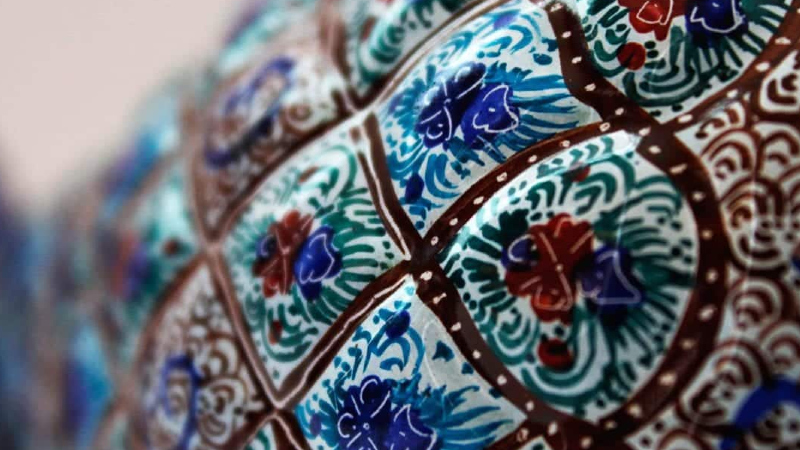
What colors are used in Mina Kari?
If you have seen one of the enameled dishes up close, you probably noticed that a wide range of colors were used in it. In the art of enameling, several different types of colors are used, including natural, mineral and metallic colors, which can be opaque or transparent and shiny.
The range of colors used in enamelware is very wide, but azure blue, pink, green, red, yellow, turquoise, gold, brown and black colors are used more than other colors. To make each of these colors, a combination of different natural and chemical substances is used. For example, green color is created with chromium oxide and other substances such as calcium fluoride or lime are used to darken or lighten it.
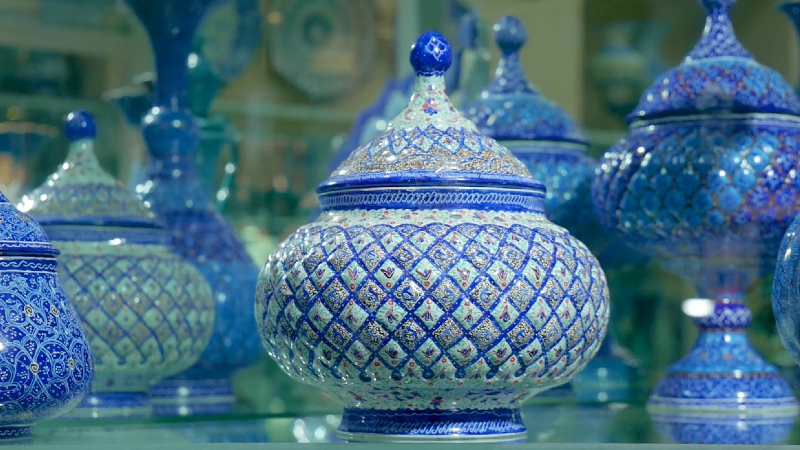
How to take care of Mina Kari handicrafts?
Minakari is one of the most delicate and sensitive Iranian handicrafts, and in order to increase the life of these dishes and prevent them from being damaged, it is necessary to observe various points.
Do not expose these containers to sharp objects
Ceramic glaze in enameled dishes and paintings on this layer are very sensitive. It is better to use these containers carefully and keep sharp objects away from them.
Do not wash Mina Kari dishes with detergents
The paintings drawn on these dishes have good resistance to washing with warm water and soft sponge, but they are damaged if they come into contact with all kinds of detergents. Chemicals and acidic compounds in detergents cause the colors of these dishes to oxidize and wipe them off.
Keep these containers away from heat
High heat causes black spots on these dishes and ruins the colors on it.
Do not pour acidic substances into these containers
Storing foods and sweets containing acidic substances such as vinegar or lemon juice will damage your container.
Repair damaged containers immediately
If part of your container is damaged due to improper use or impact, it is better to repair the damaged part immediately. Not repairing this part can cause damage to other parts of the container. You can get help from an expert for this.

